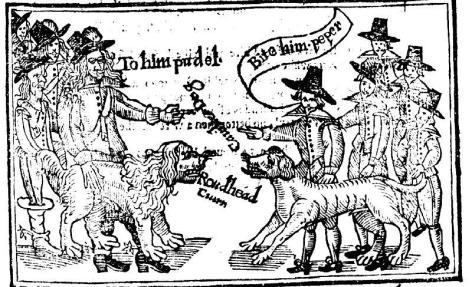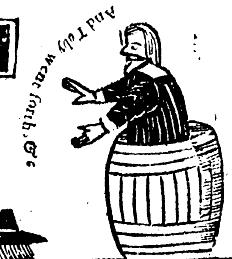Pepper and Puddle
by mercuriuspoliticus
Here’s an image with which you are probably familiar. It’s a staple of lots of textbooks and narratives of the civil wars, and is commonly used to show how deep the conflict ran – even the dogs had to take sides. But on a closer look it reveals a rather different context.
It’s a woodcut from the title page of a pamphlet published in early 1643:
A dialogue, or, Rather a parley betweene Prince Ruperts dogge whose name is Puddle, and Tobies dog whose name is Pepper, &c.
Whereunto is added the challeng which Prince Griffins dogg called Towzer, hath sent to Prince Ruperts dogg Puddle, in the behalfe of honest Pepper Tobies dog.
Moreover the said Prince Griffin is newly gone to Oxford to lay the wager, and to make up the match.
The dialogue starts with Rupert’s dog, Puddle, and Toby’s dog, Pepper, exchanging insults: “whindling Puppy Dog”, “shag haired Cavalier’s Dogge”. Pepper claims Puddle is an evil spirit, a claim which Puddle throws straight back at him, accusing him of bewitching the apprentices who rioted outside Westminster in the months before war broke out. After establishing what breed of dog they are, they trade insults on the social standing of their respective armies. Puddle contemptously rejects Pepper’s “red-cotton” soldiers, preferring the massed ranks of aristocrats he is able to list on the king’s side.
Puddle then lists the various plots he has been involved in, making Pepper so envious he begs to be told how to emulate him. Puddle reveals a plot to end all plots – a conspiracy to use 1000 barrels of gunpowder, 500 bars of iron, and 600 tonnes of stones to undermine the Thames, blowing them all up at high tide and sweeping the roundheads away.
Pepper is so impressed that he swears to deny all roundheads, and to bark at conventicles. To seal the deal, Puddle asks him to blow his nose backwards, and to fart against all sectaries. Unfortunately Pepper also ends up stinking the place out, much to Puddle’s consternation: “But I gave you no command to stink”. The dialogue closes with Puddle fetching sheeps-wool for Pepper to use as a periwig, completing his side-switching.
The dialogue is obviously a rich mine of information about the stereotypes already flourishing by 1643. There are the feather-capped, long-haired, spur-wearing cavaliers in the woodcut, contrasted against the plain-hatted roundheads. There is the rich imagery deployed by the author of the dialogue, and the scatological humour. There is also the reference to Prince Rupert’s dog, Puddle, who really existed but whose real name was Boye. Boye rode into action with Rupert on a number of occasions and built up quite a reputation amongst Parliamentarian troops as an evil spirit. Here for example is an image from a 1643 pamphlet of Rupert with his familiar.

All this can tell us a lot about the audience for such pamphlets, and the literary tropes and images that were in use at the time, making it a very useful source.
But in fact the main emphasis of the pamphlet is on something rather different. The author was John Taylor, the so- called “water poet”, a staunch royalist who would later travel to Oxford to join Charles I there. During 1642 and 1643 he became engaged in a literary spat with another pamphlet writer, Henry Walker the ironmonger. Walker was a “tub” preacher – in other words, he didn’t have a benefice. Walker is the real subject of the pamphlet. At some point in 1642 Walker had obviously delivered a sermon on the book of Tobit (in which Tobias makes a journey accompanied by a dog). A record of this does not survive, but there is a piss-take by Taylor in which Walker spouts nonsense, each paragraph ending with “and the dog of the man went with him”. There’s even a woodcut of Walker in his tub.
The dialogue between the dogs is scattered with references to this incident. There is Pepper’s owner, most obviously, as well as many references to Walker and to tub-preaching: for example, when switching sides Pepper declares: “all tub-lecturers I defie”. So the real objective of the pamphlet is to continue the battle on paper with Walker, as well as propagandising the royalist cause. Walker was certainly put out by the pamphlet: in a retort titled A Modest Vindication, he grumbled about a “foolish ridiculous Pamphlet of Tobie and his dog”. So he was clearly stung by Taylor’s caricature!
Finally, who is the mysterious Towzer, Prince Griffin’s dog? EEBO reckons it’s a reference to Roger L’Estrange, who would become a famous pamphleteer after the Restoration (but who at this point was a supporter of Parliament). In 1680 he was burnt in effigy by Londoners, who christened him the Dog Towzer. But this is far too early for L’Estrange to have been a target. The answer lies in the reference to Prince Griffin. This is likely to be John Griffith or Griffin, who had been an MP for Caernarvonshire before getting into trouble for basically duelling and killing his way round England. There is a brilliantly-titled denial of having murdered a gentleman’s servant, for example: A vindication or justification of John Griffith, Esq. Against the horrid, malitious, and unconscionable verdict of the coroners iury in Cheshire : vvhich was packt by the means of that pocky, rotten, lying, cowardly, and most perfidious knave, Sir Hugh Caulveley Knight, onely to vent his inveterate hatred and malice against me. Taylor portrays Towzer as challenging Puddle to a duel.


Thank you for another interesting examination of a pamphlet, which has set me to scouring my books.
Towzer’s challenge with its over the top language is presumably a parody of the behaviour of his master. According to Clarendon after originally supporting the court, Griffith “a young Welshman of no parts, or reputation but for eminent licence” being refused any preferment switched his alligence and “was thenceforth taken into trust and used as their bravo to justify all their excesses, in taverns and ordinaries.” (book iv p315). The title of Griffith’s own pamphlet would support this and it provides a good hint as to the audiance Taylor was aiming at.
Interestingly another pamphlet, what could be called the prosecutions case for the Cheshire incident. “A Letter of a Sad Tragedy by Prince Griffin at Sayton neere Chester, and his severall Attempts against the Lady Caufely, and the Bloody Murther for which he is Fled into Scotland. London, printed for A. C. and A. W. 1648.” is apparently illustrated with a woodcut of a man with a dog. (unfortunately not in a position to check this at present).
[…] a comment on my post on Pepper and Puddle, a reader kindly pointed out that I’d missed a picture of Prince Griffin and his dog, Towzer, in another pamphlet. The […]
Thanks dibdale, I had missed that this had a picture. I’ve dug it out and posted more about it above.
[…] Pepper and Puddle […]
[…] about blogging… Meanwhile I post about a more pompous preacher from earlier in the century, Henry Walker, and how he was caricatured in royalist […]
[…] to attack each other. Nick Poyntz has blogged about the text and I would recommend you read it, link here, for the background to this […]
Reblogged this on The visible effects of belief and commented:
A reference in “The Black Legend of Prince Rupert’s Dog” led to this